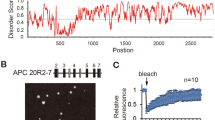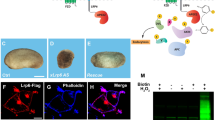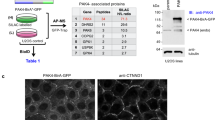Abstract
The adenomatous polyposis coli (APC) tumour suppressor is a multifunctional protein involved in the regulation of Wnt signalling and cytoskeletal dynamics. Little is known about how APC controls these disparate functions. In this study, we have used APC- and axin-fluorescent fusion proteins to examine the interactions between these proteins and show that the functionally distinct populations of APC are also spatially separate. Axin-RFP forms cytoplasmic punctate structures, similar to endogenous axin puncta. Axin-RFP recruits β-catenin destruction complex proteins, including APC, β-catenin, glycogen synthase kinase-3-β (GSK3-β) and casein kinase-1-α (CK1-α). Recruitment into axin-RFP puncta sequesters APC from clusters at cell extensions and this prevents its microtubule-associated functions. The interaction between APC-GFP and axin-RFP within the cytoplasmic puncta is direct and dramatically alters the dynamic properties of APC-GFP. However, recruitment of APC to axin puncta is not absolutely required for β-catenin degradation. Instead, formation of axin puncta, mediated by the DIX domain, is required for β-catenin degradation. An axinΔDIX mutant did not form puncta, but still mediated recruitment of destruction complex proteins and phosphorylation of β-catenin. We conclude that there are distinct pools of APC and that the formation of axin puncta, rather than the axin/APC complex, is essential for β-catenin destruction.
This is a preview of subscription content, access via your institution
Access options
Subscribe to this journal
Receive 50 print issues and online access
$259.00 per year
only $5.18 per issue
Buy this article
- Purchase on Springer Link
- Instant access to full article PDF
Prices may be subject to local taxes which are calculated during checkout






Similar content being viewed by others
References
Aberle H, Bauer A, Stappert J, Kispert A, Kemler R . (1997). Beta-catenin is a target for the ubiquitin-proteasome pathway. EMBO J 16: 3797–3804.
Barth AI, Siemers KA, Nelson WJ . (2002). Dissecting interactions between EB1, microtubules and APC in cortical clusters at the plasma membrane. J Cell Sci 115: 1583–1590.
Behrens J, Jerchow BA, Wurtele M, Grimm J, Asbrand C, Wirtz R et al. (1998). Functional interaction of an axin homolog, conductin, with beta-catenin, APC, and GSK3beta. Science 280: 596–599.
Bilic J, Huang YL, Davidson G, Zimmermann T, Cruciat CM, Bienz M et al. (2007). Wnt induces LRP6 signalosomes and promotes dishevelled-dependent LRP6 phosphorylation. Science 316: 1619–1622.
Campbell RE, Tour O, Palmer AE, Steinbach PA, Baird GS, Zacharias DA et al. (2002). A monomeric red fluorescent protein. Proc Natl Acad Sci USA 99: 7877–7882.
Catimel B, Nice EC, Karrlander M, Ross J, Catimel J, Burgess AW et al. (2006). Purification and characterization of a high specificity polyclonal antibody to the adenomatous polyposis coli tumour suppressor protein. Biomed Chromatogr 20: 569–575.
Ciani L, Krylova O, Smalley MJ, Dale TC, Salinas PC . (2004). A divergent canonical WNT-signaling pathway regulates microtubule dynamics: dishevelled signals locally to stabilize microtubules. J Cell Biol 164: 243–253.
Clayton AH, Walker F, Orchard SG, Henderson C, Fuchs D, Rothacker J et al. (2005). Ligand-induced dimer-tetramer transition during the activation of the cell surface epidermal growth factor receptor-A multidimensional microscopy analysis. J Biol Chem 280: 30392–30399.
Clevers H . (2006). Wnt/beta-catenin signaling in development and disease. Cell 127: 469–480.
Cliffe A, Hamada F, Bienz M . (2003). A role of Dishevelled in relocating Axin to the plasma membrane during wingless signaling. Curr Biol 13: 960–966.
Cong F, Schweizer L, Varmus H . (2004). Wnt signals across the plasma membrane to activate the beta-catenin pathway by forming oligomers containing its receptors, Frizzled and LRP. Development 131: 5103–5115.
Dayanandan R, Butler R, Gordon-Weeks PR, Matus A, Kaech S, Lovestone S et al. (2003). Dynamic properties of APC-decorated microtubules in living cells. Cell Motil Cytoskeleton 54: 237–247..
Fagotto F, Jho E, Zeng L, Kurth T, Joos T, Kaufmann C et al. (1999). Domains of axin involved in protein-protein interactions, Wnt pathway inhibition, and intracellular localization. J Cell Biol 145: 741–756.
Faux MC, Ross JL, Meeker C, Johns T, Ji H, Simpson RJ et al. (2004). Restoration of full-length adenomatous polyposis coli (APC) protein in a colon cancer cell line enhances cell adhesion. J Cell Sci 117: 427–439.
Fodde R . (2003). The multiple functions of tumour suppressors: it's all in APC. Nat Cell Biol 5: 190–192.
Hanley QS, Clayton AH . (2005). AB-plot assisted determination of fluorophore mixtures in a fluorescence lifetime microscope using spectra or quenchers. J Microsc 218: 62–67.
Hart M, Concordet JP, Lassot I, Albert I, del los Santos R, Durand H et al. (1999). The F-box protein beta-TrCP associates with phosphorylated beta-catenin and regulates its activity in the cell. Curr Biol 9: 207–210.
Hart MJ, de los Santos R, Albert IN, Rubinfeld B, Polakis P . (1998). Downregulation of beta-catenin by human Axin and its association with the APC tumor suppressor, beta-catenin and GSK3 beta. Curr Biol 8: 573–581.
Hsu W, Zeng L, Costantini F . (1999). Identification of a domain of Axin that binds to the serine/threonine protein phosphatase 2A and a self-binding domain. J Biol Chem 274: 3439–3445.
Kawasaki Y, Senda T, Ishidate T, Koyama R, Morishita T, Iwayama Y et al. (2000). Asef, a link between the tumor suppressor APC and G-protein signaling. Science 289: 1194–1197.
Kishida S, Yamamoto H, Hino S, Ikeda S, Kishida M, Kikuchi A . (1999). DIX domains of Dvl and axin are necessary for protein interactions and their ability to regulate beta-catenin stability. Mol Cell Biol 19: 4414–4422.
Kishida S, Yamamoto H, Ikeda S, Kishida M, Sakamoto I, Koyama S et al. (1998). Axin, a negative regulator of the wnt signaling pathway, directly interacts with adenomatous polyposis coli and regulates the stabilization of beta-catenin. J Biol Chem 273: 10823–10826.
Kita K, Wittmann T, Nathke IS, Waterman-Storer CM . (2006). Adenomatous polyposis coli on microtubule plus ends in cell extensions can promote microtubule net growth with or without EB1. Mol Biol Cell 17: 2331–2345.
Kitagawa M, Hatakeyama S, Shirane M, Matsumoto M, Ishida N, Hattori K et al. (1999). An F-box protein, FWD1, mediates ubiquitin-dependent proteolysis of beta-catenin. EMBO J 18: 2401–2410.
Korinek V, Barker N, Morin PJ, van Wichen D, de Weger R, Kinzler KW et al. (1997). Constitutive transcriptional activation by a beta-catenin-Tcf complex in APC−/− colon carcinoma. Science 275: 1784–1787.
Kroboth K, Newton IP, Kita K, Dikovskaya D, Zumbrunn J, Waterman-Storer CM et al. (2007). Lack of adenomatous polyposis coli protein correlates with a decrease in cell migration and overall changes in microtubule stability. Mol Biol Cell 18: 910–918.
Langford KJ, Askham JM, Lee T, Adams M, Morrison EE . (2006). Examination of actin and microtubule dependent APC localisations in living mammalian cells. BMC Cell Biol 7: 3.
Latres E, Chiaur DS, Pagano M . (1999). The human F box protein beta-Trcp associates with the Cul1/Skp1 complex and regulates the stability of beta-catenin. Oncogene 18: 849–854.
Lee E, Salic A, Kruger R, Heinrich R, Kirschner MW . (2003). The roles of APC and Axin derived from experimental and theoretical analysis of the Wnt pathway. PLoS Biol 1: E10.
Leibovitz A, Stinson JC, McCombs III WB, McCoy CE, Mazur KC, Mabry ND . (1976). Classification of human colorectal adenocarcinoma cell lines. Cancer Res 36: 4562–4569.
Levina E, Oren M, Ben-Ze’ev A . (2004). Downregulation of beta-catenin by p53 involves changes in the rate of beta-catenin phosphorylation and Axin dynamics. Oncogene 23: 4444–4453.
Logan CY, Nusse R . (2004). The Wnt signaling pathway in development and disease. Annu Rev Cell Dev Biol 20: 781–810.
Magde D, Rojas GE, Seybold PG . (1999). Solvent dependence of the fluorescence lifetimes of xanthene dyes. Photochem Photobiol 70: 737–744.
Mimori-Kiyosue Y, Shiina N, Tsukita S . (2000). Adenomatous polyposis coli (APC) protein moves along microtubules and concentrates at their growing ends in epithelial cells. J Cell Biol 148: 505–518.
Munemitsu S, Albert I, Souza B, Rubinfeld B, Polakis P . (1995). Regulation of intracellular beta-catenin levels by the adenomatous polyposis coli (APC) tumor-suppressor protein. Proc Natl Acad Sci USA 92: 3046–3050.
Munemitsu S, Souza B, Muller O, Albert I, Rubinfeld B, Polakis P . (1994). The APC gene product associates with microtubules in vivo and promotes their assembly in vitro. Cancer Res 54: 3676–3681.
Nakamura M, Zhou XZ, Lu KP . (2001). Critical role for the EB1 and APC interaction in the regulation of microtubule polymerization. Curr Biol 11: 1062–1067.
Nakamura T, Hamada F, Ishidate T, Anai K, Kawahara K, Toyoshima K et al. (1998). Axin, an inhibitor of the Wnt signalling pathway, interacts with beta-catenin, GSK-3beta and APC and reduces the beta-catenin level. Genes Cells 3: 395–403.
Nathke IS . (2004). The adenomatous polyposis coli protein: the Achilles heel of the gut epithelium. Annu Rev Cell Dev Biol 20: 337–366.
Nathke IS, Adams CL, Polakis P, Sellin JH, Nelson WJ . (1996). The adenomatous polyposis coli tumor suppressor protein localizes to plasma membrane sites involved in active cell migration. J Cell Biol 134: 165–179.
Orford K, Crockett C, Jensen JP, Weissman AM, Byers SW . (1997). Serine phosphorylation-regulated ubiquitination and degradation of beta-catenin. J Biol Chem 272: 24735–24738.
Park TJ, Gray RS, Sato A, Habas R, Wallingford JB . (2005). Subcellular localization and signaling properties of dishevelled in developing vertebrate embryos. Curr Biol 15: 1039–1044.
Penman GA, Leung L, Nathke IS . (2005). The adenomatous polyposis coli protein (APC) exists in two distinct soluble complexes with different functions. J Cell Sci 118: 4741–4750.
Polakis P . (1997). The adenomatous polyposis coli (APC) tumor suppressor. Biochim Biophys Acta 1332: F127–F147.
Polakis P . (2000). Wnt signaling and cancer. Genes Dev 14: 1837–1851.
Sage D, Neumann FR, Hediger F, Gasser SM, Unser M . (2005). Automatic tracking of individual fluorescence particles: application to the study of chromosome dynamics. IEEE Trans Image Process 14: 1372–1383.
Sakanaka C, Williams LT . (1999). Functional domains of axin. Importance of the C terminus as an oligomerization domain. J Biol Chem 274: 14090–14093.
Saxton MJ, Jacobson K . (1997). Single-particle tracking: applications to membrane dynamics. Annu Rev Biophys Biomol Struct 26: 373–399.
Schneikert J, Behrens J . (2007). The canonical Wnt signalling pathway and its APC partner in colon cancer development. Gut 56: 417–425.
Schwarz-Romond T, Fiedler M, Shibata N, Butler PJ, Kikuchi A, Higuchi Y et al. (2007a). The DIX domain of Dishevelled confers Wnt signaling by dynamic polymerization. Nat Struct Mol Biol 14: 484–492.
Schwarz-Romond T, Merrifield C, Nichols BJ, Bienz M . (2005). The Wnt signalling effector Dishevelled forms dynamic protein assemblies rather than stable associations with cytoplasmic vesicles. J Cell Sci 118: 5269–5277.
Schwarz-Romond T, Metcalfe C, Bienz M . (2007b). Dynamic recruitment of axin by Dishevelled protein assemblies. J Cell Sci 120: 2402–2412.
Sharma M, Leung L, Brocardo M, Henderson J, Flegg C, Henderson BR . (2006). Membrane localization of adenomatous polyposis coli protein at cellular protrusions: targeting sequences and regulation by beta-catenin. J Biol Chem 281: 17140–17149.
Smalley MJ, Sara E, Paterson H, Naylor S, Cook D, Jayatilake H et al. (1999). Interaction of axin and Dvl-2 proteins regulates Dvl-2-stimulated TCF-dependent transcription. EMBO J 18: 2823–2835.
Su LK, Burrell M, Hill DE, Gyuris J, Brent R, Wiltshire R et al. (1995). APC binds to the novel protein EB1. Cancer Res 55: 2972–2977.
van Munster EB, Gadella Jr TW . (2004). Suppression of photobleaching-induced artifacts in frequency-domain FLIM by permutation of the recording order. Cytometry A 58: 185–194.
Watanabe T, Wang S, Noritake J, Sato K, Fukata M, Takefuji M et al. (2004). Interaction with IQGAP1 links APC to Rac1, Cdc42, and actin filaments during cell polarization and migration. Dev Cell 7: 871–883.
Wen Y, Eng CH, Schmoranzer J, Cabrera-Poch N, Morris EJ, Chen M et al. (2004). EB1 and APC bind to mDia to stabilize microtubules downstream of Rho and promote cell migration. Nat Cell Biol 6: 820–830.
Wiechens N, Heinle K, Englmeier L, Schohl A, Fagotto F . (2004). Nucleo-cytoplasmic shuttling of Axin, a negative regulator of the Wnt-beta-catenin Pathway. J Biol Chem 279: 5263–5267.
Wilson KM, Morrison IE, Smith PR, Fernandez N, Cherry RJ . (1996). Single particle tracking of cell-surface HLA-DR molecules using R-phycoerythrin labeled monoclonal antibodies and fluorescence digital imaging. J Cell Sci 109 (Part 8): 2101–2109.
Winston JT, Strack P, Beer-Romero P, Chu CY, Elledge SJ, Harper JW . (1999). The SCFbeta-TRCP-ubiquitin ligase complex associates specifically with phosphorylated destruction motifs in IkappaBalpha and beta-catenin and stimulates IkappaBalpha ubiquitination in vitro. Genes Dev 13: 270–283.
Zeng L, Fagotto F, Zhang T, Hsu W, Vasicek TJ, Perry III WL et al. (1997). The mouse Fused locus encodes Axin, an inhibitor of the Wnt signaling pathway that regulates embryonic axis formation. Cell 90: 181–192.
Acknowledgements
We thank Dr M Prescott, Dr F Costantini and Dr D Capelluto for cDNA constructs. MCF, MJL and AWB are supported by NH&MRC program grant 234703; AHAC is an NH&MRC RD Wright Research Fellow.
Author information
Authors and Affiliations
Corresponding author
Additional information
Supplementary Information accompanies the paper on the Oncogene website (http://www.nature.com/onc)
Rights and permissions
About this article
Cite this article
Faux, M., Coates, J., Catimel, B. et al. Recruitment of adenomatous polyposis coli and β-catenin to axin-puncta. Oncogene 27, 5808–5820 (2008). https://doi.org/10.1038/onc.2008.205
Received:
Revised:
Accepted:
Published:
Issue Date:
DOI: https://doi.org/10.1038/onc.2008.205
Keywords
This article is cited by
-
The scaffold protein AXIN1: gene ontology, signal network, and physiological function
Cell Communication and Signaling (2024)
-
APC mutations disrupt β-catenin destruction complex condensates organized by Axin phase separation
Cellular and Molecular Life Sciences (2024)
-
Multivalent tumor suppressor adenomatous polyposis coli promotes Axin biomolecular condensate formation and efficient β-catenin degradation
Scientific Reports (2020)
-
Pathogenic LRRK2 variants are gain-of-function mutations that enhance LRRK2-mediated repression of β-catenin signaling
Molecular Neurodegeneration (2017)
-
The Wnt/β-catenin pathway in human fibrotic-like diseases and its eligibility as a therapeutic target
Molecular and Cellular Therapies (2015)



